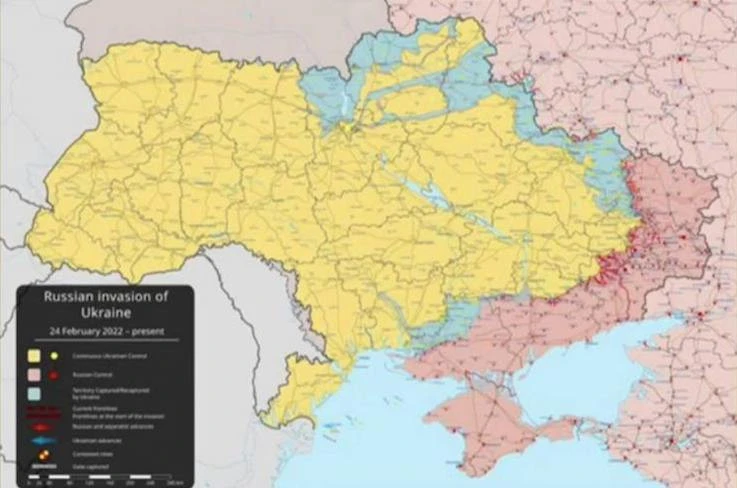
Russia-Ukraine war reaches new levels in objectives, cost, and losses. Serhiy Zgurets' column
For three years, Putin has used all nuclear-state resources to destroy Ukraine, while both sides have adapted their warfare on land, sea, and air
The third anniversary of Russia's full-scale aggression
Three years ago, the Russian army launched a full-scale invasion of Ukraine. The war, which has been going on since 2014, has reached a new level in terms of goals, cost, and casualties. It has become the largest and bloodiest war in Europe since the end of World War II. And during these three years, Putin has been using all the efforts of his nuclear power to try to destroy Ukraine.
Let's take a look at the map of the fighting to understand the dynamics.

Blue marks the territories that, following the insidious invasion in 2022, were liberated by the Ukrainian Defense Forces through a series of successful counteroffensive operations. The areas currently under Russian control are marked in red. Russia has paid, and continues to pay, a huge price for the territories marked in red — 198,000 killed and over 550,000 wounded. At least three times, Russia’s most combat-ready units that invaded Ukraine in 2022 have been destroyed.
Ukraine's losses, of course, are smaller, but they are extremely painful. Every Ukrainian has relatives and friends who are currently at war and holding the line. We must once again express our gratitude to them for holding back the occupying Russian army.
Over these three years, both sides have been transforming their approaches to warfare on land, at sea, and in the air. We talked about some of these changes and approaches with military expert with the Center for Defense Strategies of Ukraine, Colonel with the Ukrainian Armed Forces, Viktor Kevliuk.
The military expert highlighted Ukraine's key achievements: first, that the state of Ukraine continues to exist in the form it was conceived in 1991. Secondly, the Defense Forces have maintained their units, command structure, and continue to resist a numerically superior enemy, which in some respects outnumbers them significantly. Ukrainian defense forces are effectively conducting air defense operations, carrying out a strategic effort to systematically destroy the Russian oil refining industry, and striking at considerable depths. They are also successfully maintaining territorial defense, enhancing protection of the state border and safeguarding state authorities. In other words, the tasks assigned to territorial defense are being fulfilled. It is important to note that state sovereignty remains intact in the territory controlled by Ukraine.
The expert believes that the first successful defense operation was the defense of Kyiv. The defeated Russian landing near Hostomel prevented them from executing their plan to airlift an assault echelon to airfields close to Kyiv, which would have led to an invasion of the capital. According to most estimates, losing the capital would have resulted in defeat in the war, but this did not happen.
The second success was the offensive operation near Kharkiv, which liberated almost the entire Kharkiv region. It was a surprise for Russia — skillfully executed, fast, and achieved with limited resources, yet very successful.
The operation to drive Russian troops out of the Kherson region should also be considered a success. The Ukrainian Armed Forces created a threat of encirclement, forcing Russian troops to abandon their defense of the city of Kherson. Everyone remembers how former Russian General Surovikin reported to Putin, requesting permission to withdraw troops to the left bank of the Dnipro river.
Another successful operation was the defense of the village of Krynky. Thanks to the successful actions of the Ukrainian marines on the left bank, a significant Russian group was restrained, preventing it from being used in the Donetsk direction. If this had not occurred, events in that area could have been much more critical for Ukraine.
The next operation classified as successful by Viktor was in the Kursk region. It’s important to note that the sudden actions at the operational level in both Kharkiv and Kursk regions allowed the military leadership of the Ukrainian Defense Forces to achieve surprise. This is a very complex and difficult set of measures, but each time it catches the Russians off guard, leading to the loss of vast territories.
Currently, although the territory has been reduced, about 580 square kilometers remain under Ukrainian control. This area is crucial for two reasons: first, diplomats must leverage it successfully in negotiations to strengthen Ukraine's position; and second, the Russian group of 55,000 troops must recapture their own territory, forcing their aviation to destroy their own settlements. The world sees that there are no “red lines” except in the speeches of Russian leaders. This is a very telling situation, not only from a military standpoint but also from a military-political one.
Regarding Bakhmut, the situation is quite controversial. On one hand, the prolonged defense of the city showcases the military capabilities of the Ukrainian Defense Forces in this area. On the other hand, the "Bakhmut fortress" exists only in songs. Where are the fortifications around this so-called fortress? It is not entirely clear. That is why, after the war, not only military historians but also law enforcement agencies should be involved to determine why Ukrainian soldiers were defending themselves essentially in an open field.
The Ukrainian Armed Forces reserve colonel emphasized that the political leadership must finally recognize its responsibility for the fate of the nation and make a decisive move on the military strategy — specifically, a strategy for victory. Currently, Ukraine is operating under a military security strategy from 2021, which no longer aligns with the reality of the ongoing war. In terms of military-political changes, Ukraine is strong in mobile operations and technology, which the Ukrainian Defense Forces should transform into their capabilities.
At present, the primary burden of the war falls on the infantry, engaging in combat about 5 km from the front lines, relying on small arms and FPV drones. Once the Ukrainian Defense Forces manage to shift the focus of combat operations to a depth of 30 to 300 km, Russian forces will face a multitude of challenges with air defense, army aviation bases, logistics, command and control systems, and communications. This shift would, on one hand, ease the pressure on Ukrainian infantry, but on the other, it would strain Russian army aviation, artillery, missile forces, and strike aircraft. To achieve this, the military leadership must create a new concept, similar to NATO’s Air Assault Concept, and adapt it to Ukraine’s realities by studying such materials.
The officer pointed out that Ukraine possesses a set of capabilities, though unfortunately underdeveloped, where it outperforms Russia. For example, the Delta system, unmanned aerial systems, and an advantage in command and control and intelligence, including access to satellite intelligence provided by Ukraine’s partners. All of these assets should be integrated into unified information and intelligence centers. This information should be made horizontally accessible to units using firepower across all ranges. Accordingly, everything must be effectively coordinated. Of course, it is easy to talk about in theory and may sound simple, but if the military command, at the level of the Commander-in-Chief and the General Staff, prepares the relevant administrative documents and outlines a vision of the war based on the use of Ukraine's advantages, the outcome could be much more positive than what we are seeing now.
Kevliuk explained that in a mechanized brigade, a company of reconnaissance and strike unmanned aerial vehicles consists of about 50 specialists, who are responsible for 70-90% of the targets hit. In contrast, the 81 infantry units in the same brigade, totaling around 648 infantrymen, account for just 5% of the targets hit. The emphasis should be placed on how much each element contributes to the "piggy bank" of success. Of course, infantry is crucial, and it will be the infantryman who “raises the Ukrainian national flag over the Kremlin,” but everyone else must create the conditions for that moment. The forces supporting the infantry must be developed accordingly, as they do not require large numbers of personnel.
- News










































